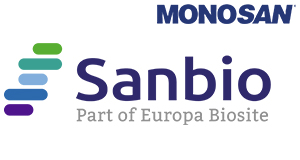Rabbit anti-GLUT1, recombinant (monoclonal)
Rabbit anti-GLUT1, recombinant (monoclonal)
SKU
SANMON23501
Packaging Unit
0,5 ml
Manufacturer
Sanbio / Monosan
Availability:
loading...
Price is loading...
Immunogen: Recombinant fragment of human SLC2A1 protein
Concentration: 0.2 mg/ml
Format: Purified protein A/G
Storage buffer: 10mM PBS with 0.05% BSA & 0.05% azide
Additional info: Glucose transporter 1 (or GLUT1), also known as solute carrier family 2, facilitated glucose transporter member 1 (SLC2A1) protein is coded by the SLC2A1 gene on chromosome 1p34.2. GLUT1 facilitates the transport of glucose across the plasma membranes of cells. Glut1 is also a receptor for vitamin C uptake and the human T-cell leukemia virus (HTLV) I and II. GLUT1 expression occurs in almost all tissues. The level of GLUT1 expression parallels the rate of cellular glucose metabolism. It is particularly high in erythrocytes and in endothelial cells of the blood–brain barrier. GLUT1 is often overexpressed in cancer because many tumors exert a metabolic switch from oxidative phosphorylation to glycolysis which requires an elevated uptake of glucose. In cancer GLUT1 represents a potential therapeutic target for GLUT1 inhibitors such as Bay-876. In normal tissues, the strongest GLUT1 immunostaining is seen in amnion, chorion, and trophoblast cells of the placenta. GLUT1 staining is also strong in all erythrocytes and their precursor cells. GLUT1 staining of endothelial cells is depending on the location and tissue type. It is strongest in the brain. An at least weak to moderate staining is seen in squamous epithelium and urothelium as well as in dendritic cells of germinal centres. Among tumors, a positive GLUT1 immunostaining is preferentially seen in squamous cell carcinomas irrespective of their origin but at least a small fraction of GLUT1 positive cases also occurs in a broad range of other tumor entities.
Concentration: 0.2 mg/ml
Format: Purified protein A/G
Storage buffer: 10mM PBS with 0.05% BSA & 0.05% azide
Additional info: Glucose transporter 1 (or GLUT1), also known as solute carrier family 2, facilitated glucose transporter member 1 (SLC2A1) protein is coded by the SLC2A1 gene on chromosome 1p34.2. GLUT1 facilitates the transport of glucose across the plasma membranes of cells. Glut1 is also a receptor for vitamin C uptake and the human T-cell leukemia virus (HTLV) I and II. GLUT1 expression occurs in almost all tissues. The level of GLUT1 expression parallels the rate of cellular glucose metabolism. It is particularly high in erythrocytes and in endothelial cells of the blood–brain barrier. GLUT1 is often overexpressed in cancer because many tumors exert a metabolic switch from oxidative phosphorylation to glycolysis which requires an elevated uptake of glucose. In cancer GLUT1 represents a potential therapeutic target for GLUT1 inhibitors such as Bay-876. In normal tissues, the strongest GLUT1 immunostaining is seen in amnion, chorion, and trophoblast cells of the placenta. GLUT1 staining is also strong in all erythrocytes and their precursor cells. GLUT1 staining of endothelial cells is depending on the location and tissue type. It is strongest in the brain. An at least weak to moderate staining is seen in squamous epithelium and urothelium as well as in dendritic cells of germinal centres. Among tumors, a positive GLUT1 immunostaining is preferentially seen in squamous cell carcinomas irrespective of their origin but at least a small fraction of GLUT1 positive cases also occurs in a broad range of other tumor entities.
| SKU | SANMON23501 |
|---|---|
| Manufacturer | Sanbio / Monosan |
| Manufacturer SKU | MON23501 |
| Package Unit | 0,5 ml |
| Quantity Unit | STK |
| Reactivity | Human |
| Clonality | Monoclonal |
| Application | Immunohistochemistry (paraffin) |
| Isotype | IgG |
| Host | Rabbit |
| Conjugate | Unconjugated |
| Product information (PDF) |
|
| MSDS (PDF) |
|

 Deutsch
Deutsch







